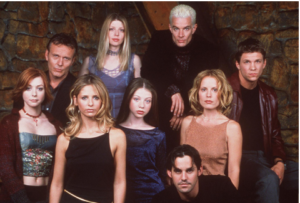FOCUS
#03
Buffy, the cliché slayer
By Céline Morin, senior lecturer, director of the Information-Communication Department at Paris-Nanterre University, affiliate researcher of the HAR/ Irméccen Laboratory (Paris Nanterre/ Sorbonne Nouvelle) and Alexandre Diallo, postdoctoral researcher at Paris 1 Sorbonne University, course lecturer at SciencesPo Paris and affiliate researcher of the Maurice Halbwachs Centre (EHESS-ENS-CNRS).
Overview: Buffy the Vampire Slayer sparked a structural change in the production of television series. By breaking the mould of simple Hollywood storylines, its creator paved the way for new forms of fiction rejecting gender stereotypes. The series also showed how popular culture products could lead to a political debate on our societies.
In the series Buffy the Vampire Slayer, Sarah Michelle Gellar plays a teenager fighting against the evil forces (vampires, demons, spirits). From 1997 onwards, the average audience for each episode ranged between 4 and 6 million in the US, while the series, included in the Saturday night program of the French TV channel M6 (La Trilogie du Samedi Soir) reached several million viewers. As the flagship series of its era, Buffy is characterised by two breaches.
Firstly, Joss Whedon, the creator, has chosen not to follow the Hollywood tradition where “the blonde girl walks into a dark alley and gets herself killed”. Buffy represents a new type of heroine, who combines innocent blondness and the use of violence.
Buffy’s predecessors, Charlie’s Angels (1976-1981), carried out a stigma reversal: they turned their much-depreciated femininity into their major strength, in order to disarm the macho enemy. Buffy goes beyond this trap-like strategy, and turns the stereotype of the candid young girl into a “virago”: a powerful woman able to arouse a zombie-like male desire as well as to repel it. By controlling her powers, killing dozens of vampires every week, and saving the world in every season, the stigmatized thin, blond woman becomes a young girl with tremendous physical strength, able to keep up with her studies during the day and to walk through cemeteries at night.
Buffy may wander and doubt, but she is not afraid of her mission or her enemies, which makes her a crucial turning point in women’s representations. Many other shows followed, directly or indirectly inspired by this character, such as Charmed, Dark Angel, Alias, Veronica Mars, Doctor Who… up to a reboot of the original series with an African American actress playing Buffy. The series marks a historical moment in feminism (Laugier, 2017), through the consequences of reversing (and cancelling) a hackneyed Hollywood formula.
“BUFFY KILLED THE HOLLYWOOD CLICHÉ OF THE DEFENSELESS YOUNG BLONDE GIRL. SHE IS NOW A WOMAN EXPECTED TO SAVE THE WORLD”
Secondly, the series has gained considerable recognition even far beyond its fandom. It became a true object of popular culture, proving that images circulate within the society and can encourage a political debate.
To start with, the series received many nominations, pushing it out of the restrictive framework of pure sci-fi entertainment. It was nominated for the prestigious Golden Globes, and won Emmy and SFX Awards. Empire magazine called it the second-best series of all time. TV Guide magazine ranked it among the 50 best TV shows, while Entertainment Weekly ranked it 13th in its Top 100 best TV series. A common agreement is shared by the French- speaking press on the place of the series. In its ranking based on the votes of 22 French- (Switzerland) placed the series among the 50 best series ever made, Time Out ranked it 16th best series, while the French radio station France Inter ranked it among the best series. Beyond the numerous rankings in the specialist press, it is also ranked in the general media. The series was acclaimed as a genre series, yet instead of being confined to the vampire (or sci-fi) genre, it went further than that and became part of the broader teen drama genre.
The series then went off-screen and settled into everyday life. Numerous extensions were made: six video games between 2000 and 2009, card games, DVDs, RPGs, more than 80 novels, fan fictions, and a spin-off series. As a true franchise, the series manages to address its fans, but also to open up to a wider group of enthusiasts, i.e. individuals who have with this type of media “a sustained, researched, and elaborate approach, regardless of the media or procedures” (Hennion & al., 2000).
Lastly, the series gave rise to many works: the Buffy studies, nringing together different disciplines – sociology, communication, philosophy, feminism and psychology. This academic recognition highlighted the links between popular culture and political & philosophical thinking. In the words of its founder: “its always important for academics to study popular culture, even if the thing they are studying is idiotic. If it’s successful or made a dent in culture, then it is worthy of study to find out why. (…) We think very carefully about what we’re trying to say emotionally, politically, and even philosophically while we’re writing it… So it really is, apart from being a big pop culture phenomenon, something that is deeply layered textually episode by episode”.
“TRUE POP CULTURE PHENOMENON, BUFFY WENT OFF SCREEN TO LEAD TO DEBATE AND ACTION”.
Buffy the Vampire Slayer represents a turning point in the history of television series. In international structural change in the production of television series. By placing the audience in the footsteps of a heroine who broke the mould of Hollywood simple storylines, the creator of the series paved the way for new forms of fiction rejecting gender stereotypes. The series also marked an important moment in the search for legitimacy of the series format by building communities, and thereby demonstrating how popular culture products can be used to engage in political debate about our societies.
L’Observatoire des images, is the first associative body that gather those who are interested in the role of images in cinema, television, video games and advertisements, especially on the Internet.
— Join Us : observatoiredesimages.org




